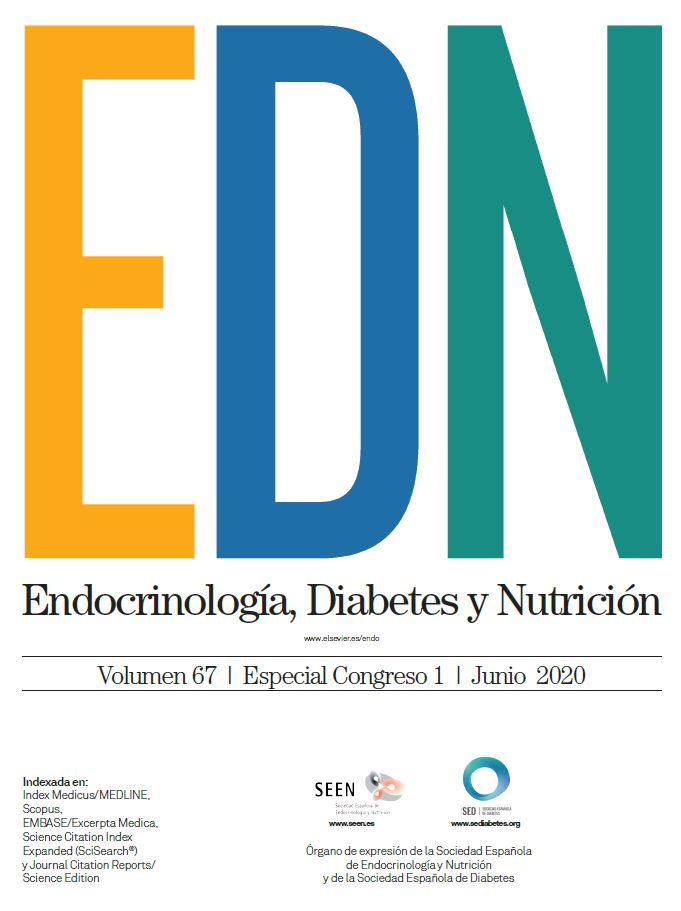P-105 - T2D DISTURBS POST-PRANDIAL METABOLIC RESPONSE OF CIRCULATING SUCCINATE
aEndocrinología y Nutrición, Instituto de Investigación Sanitaria Pere Virgili, Hospital Universitario de Tarragona Joan XXIII, CIBERDEM, Universidad Rovira i Virgili, Tarragona. bDepartamento de Medicina y Cirugía, Hospital Universitario de Tarragona Joan XXIII, Instituto de Investigación Sanitaria Pere Virgili, Tarragona. cEndocrinología y Nutrición, Hospital Universitario de Tarragona Joan XXIII, Universidad Rovira i Virgili, Tarragona. dInstituto de Investigación Sanitaria Pere Virgili, Hospital Universitario de Tarragona Joan XXIII, CIBERDEM, Universidad Rovira i Virgili, Tarragona. eInstitut d'Investigació Sanitària Pere i Virgili, Tarragona.
Introduction: There is now extensive evidences that succinate is a pleiotropic metabolite, functioning not just as an energy intermediary, but also as a signalling metabolite both in the cytosol and extracellularly via its cognate receptor SUCNR1. However, there are few information regarding its function and origin.
Objectives: To determine the contribution of glucose sensing for the gastrointestinal tract to the plasma succinate levels. Moreover, to explore the succinate response to a nutrient ingestion in a range of glucose tolerance.
Material and methods: Thirty volunteers were recruited from the general population to participate in a program of dietary counselling. First, subjects received a 3-hour OGTT (75 g glucose). In a second day, subjects received an isoglycaemic variable intravenous glucose infusion (ISO) to exactly reproduce the glycaemia from OGTT.
Results: Subjects were stratified in two groups: nondiabetic (n = 19, 37 ± 12 years, BMI 28.1 ± 4.0 and A1c 5.1 ± 0.2%) and naïve-T2D (n = 11, 46 ± 9 years, BMI 29.5 ± 3.1 and A1c 5.5 ± 0.3%) according to ADA criteria. Plasma glucose curve from OGTT was successfully reproduced during ISO (p = ns for both groups). Naïve-T2D subjects were hyperglycaemic showing higher values of 2-hours glucose (from 125.5 ± 20.1 to 157.5 ± 42.7 mmol/L, p = 0.01, respectively for nondiabetic and naïve-T2D groups) and, maximal glucose during OGTT (from 171.0 ± 16.0 to 226.1 ± 22.4 mmol/L, p < 0.0001, respectively for nondiabetic and naïve-T2D groups). The AUC of insulin (p < 0.0001), C-peptide (p < 0.0001) and GLP-1 (p < 0.0001) were increased in response to OGTT in comparison to ISO (p-values for both groups). Moreover, naïve-T2D group exhibited higher AUC of insulin (p < 0.0001), C-peptide (p < 0.0001), GLP-1 (p < 0.0001) and insulin resistance (OGIS) (p = 0.02) in comparison to the nondiabetic group during OGTT. Fasting succinate increased from 43.7 ± 16.4 to 78.4 ± 23.7 μmol/L (p = 0.01) for the comparison between nondiabetic and naïve-T2D subjects. In response to the oral ingestion of glucose, the naïve-T2D group presented higher values of AUCsuccinate (from 13,130.4 ± 3,862.8 to 22,760.7 ± 6,231.8 μmol/L, p = 0.001 vs nondiabetic group). Remarkably, glycaemia di per se (ISO) is able to stimulate succinate response however it was 22% smaller (p < 0.0001 for the AUCsuccinate for both groups). Using whole data, fasting succinate levels were associated with: A1c% (p = 0.002, r = 0.629), fasting C-peptide (p = 0.04, r = 0.460), triglycerides (p = 0.05, r = 0.409) and, the maximal glucose during OGTT (p = 0.01, r = 0.543).
Conclusions: At equal levels of glycaemia, plasma succinate response is increased in response to an oral in comparison to an intravenous glucose administration. Moreover, fasting succinate is positively associated with the progression of glucose intolerance. Finally, at least a part of plasma succinate is originated from the gastrointestinal tract and its response to the OGTT/ISO testes parallels the typical patterns of response of the insulin, C-peptide and GLP-1 both in non-diabetic and patients newly diagnosed with T2D.







